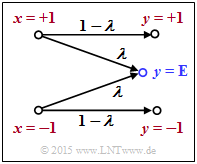Difference between revisions of "Aufgaben:Exercise 4.1Z: Log Likelihood Ratio at the BEC Model"
| Line 29: | Line 29: | ||
Hints:: | Hints:: | ||
* This exercise belongs to the chapter [[Channel_Coding/Soft-in_Soft-Out_Decoder| "Soft–in Soft–out Decoder"]]. | * This exercise belongs to the chapter [[Channel_Coding/Soft-in_Soft-Out_Decoder| "Soft–in Soft–out Decoder"]]. | ||
| − | * Reference is made in particular to the page [[Channel_Coding/Soft-in_Soft-Out_Decoder#Reliability_information_-_Log_Likelihood_Ratio| "Reliability Information – Log Likelihood Ratio"]] and to the page [[Channel_Coding/Channel_Models_and_Decision_Structures#Binary_Erasure_Channel_.E2.80.93_BEC|''Binary Erasure Channel'']. | + | * Reference is made in particular to the page [[Channel_Coding/Soft-in_Soft-Out_Decoder#Reliability_information_-_Log_Likelihood_Ratio| "Reliability Information – Log Likelihood Ratio"]] and to the page [[Channel_Coding/Channel_Models_and_Decision_Structures#Binary_Erasure_Channel_.E2.80.93_BEC|''Binary Erasure Channel'']]. |
Revision as of 18:03, 27 October 2022
We consider the so-called "BEC channel model" (binary erasure channel) with.
- the input variable $x ∈ \{+1, \, -1\}$,
- the output variable $y ∈ \{+1, \, -1, \, {\rm E}\}$, and
- the erasure probability $\lambda$.
Here $y = {\rm E}$ (erasure) means that the initial value $y$ could neither be decided as $+1$ nor as $-1$ .
Also known are the input probabilities
- $${\rm Pr}(x = +1) = 3/4\hspace{0.05cm}, \hspace{0.5cm}{\rm Pr}(x = -1) = 1/4\hspace{0.05cm}.$$
The LLR of the binary random variable $x$ is given by bipolar approach as follows:
- $$L(x)={\rm ln} \hspace{0.15cm} \frac{{\rm Pr}(x = +1)}{{\rm Pr}(x = -1)}\hspace{0.05cm}.$$
Correspondingly, for the conditional LLR in the forward direction for all $y ∈ \{+1, \, -1, \, {\rm E}\}$:
- $$L(y\hspace{0.05cm}|\hspace{0.05cm}x) = {\rm ln} \hspace{0.15cm} \frac{{\rm Pr}(y\hspace{0.05cm}|\hspace{0.05cm}x = +1)}{{\rm Pr}(y\hspace{0.05cm}|\hspace{0.05cm}x = -1)} \hspace{0.05cm}. $$
Hints::
- This exercise belongs to the chapter "Soft–in Soft–out Decoder".
- Reference is made in particular to the page "Reliability Information – Log Likelihood Ratio" and to the page Binary Erasure Channel.
Questions
Solution
- $$L(x)={\rm ln} \hspace{0.15cm} \frac{{\rm Pr}(x = +1)}{{\rm Pr}(x = -1)} ={\rm ln} \hspace{0.15cm} \frac{3/4}{1/4}\hspace{0.15cm}\underline{= 1.099}\hspace{0.05cm}.$$
(2) According to the definition
- $$L(x)={\rm ln} \hspace{0.15cm} \frac{\rm Pr}(x = +1)}{\rm Pr}(x = -1)}$$
yields the following equation of determination for $L(x) = \, -2$:
- $$\hspace{0.15cm} \frac{{\rm Pr}(x = +1)}{1-{\rm Pr}(x = +1)} \stackrel{!}{=}{\rm e}^{-2} \approx 0.135 \hspace{0.25cm}\Rightarrow \hspace{0.25cm} 1.135 \cdot {\rm Pr}(x = +1)\stackrel{!}{=}0.135\hspace{0.3cm} \Rightarrow \hspace{0.3cm} {\rm Pr}(x = +1) = 0.119\hspace{0.05cm},\hspace{0.4cm}{\rm Pr}(x = -1) \hspace{0.15cm}\underline{= 0.881}\hspace{0.05cm}. $$
(3) For the conditional LLR $L(y = {\rm E} \hspace{0.05cm} |\hspace{0.05cm} x)$ in the forward direction, for the given BEC model:
- $$L(y = {\rm E}\hspace{0.05cm}|\hspace{0.05cm}x) = {\rm ln} \hspace{0.15cm} \frac{{\rm Pr}(y= {\rm E}\hspace{0.05cm}|\hspace{0.05cm}x = +1)}{{\rm Pr}(y= {\rm E}\hspace{0.05cm}|\hspace{0.05cm}x = -1)} = {\rm ln} \hspace{0.15cm} \frac{\lambda}{\lambda}\hspace{0.15cm}\underline{= 0}\hspace{0.05cm}.$$
(4) Analogous to the sample solution of subtask (3), we obtain for $y = ±1$:
- $$L(y = +1\hspace{0.05cm}|\hspace{0.05cm}x) \hspace{-0.15cm} \ = \ \hspace{-0.15cm} {\rm ln} \hspace{0.15cm} \frac{{\rm Pr}(y= +1\hspace{0.05cm}|\hspace{0.05cm}x = +1)}{{\rm Pr}(y= +1\hspace{0.05cm}|\hspace{0.05cm}x = -1)} = {\rm ln} \hspace{0.15cm} \frac{1-\lambda}{0}\hspace{0.15cm}\underline{ \hspace{0.05cm}\Rightarrow \hspace{0.15cm}+\infty }\hspace{0.05cm},$$
- $$L(y = -1\hspace{0.05cm}|\hspace{0.05cm}x) \hspace{-0.15cm} \ = \ \hspace{-0.15cm} {\rm ln} \hspace{0.15cm} \frac{{\rm Pr}(y= -1\hspace{0.05cm}|\hspace{0.05cm}x = +1)}{{\rm Pr}(y= -1\hspace{0.05cm}|\hspace{0.05cm}x = -1)} = {\rm ln} \hspace{0.15cm} \frac{0}{1-\lambda}\hspace{0.15cm}\underline{ \hspace{0.05cm}\Rightarrow \hspace{0.15cm}-\infty }\hspace{0.05cm}. $$
Accordingly, the proposed solutions 1 and 2 are correct.
(5) Correct is the last proposed solution:
- For $\lambda = 0$ (ideal channel), $L(y = {\rm E} \hspace{0.05cm} |\hspace{0.05cm} x) = \ln {(0/0)}$ ⇒ indefinite result.
- For $\lambda = 1$ (complete erasure, $y ≡ {\rm E}$) $L(y = +1 \hspace{0.05cm} |\hspace{0.05cm} x)$ and $L(y = \, -1 \hspace{0.05cm} |\hspace{0.05cm} x)$ are indeterminate.
